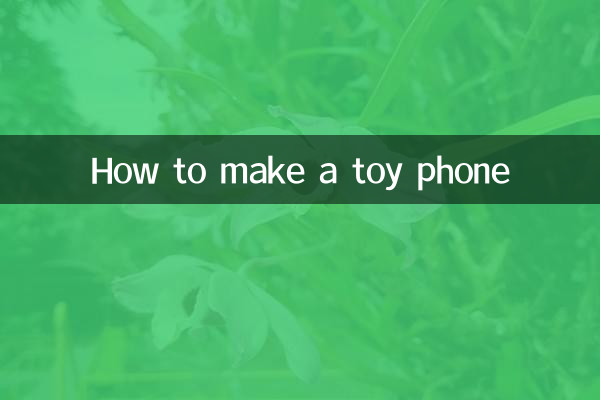How to make a toy phone
In today's fast-paced life, hand-made toy phones is not only a fun parent-child activity, but also inspires children's creativity and hands-on ability. This article will combine popular topics and hot contents on the Internet for the past 10 days to introduce you in detail how to make a simple toy phone, with relevant data and steps.
1. Analysis of hot topics and hot content

According to recent online search data, handmade DIY toys, parent-child interaction and environmentally friendly materials production have become hot topics. The following are the search popularity rankings for related topics in the past 10 days:
| Ranking | Hot Topics | Searches (10,000 times) |
|---|---|---|
| 1 | Handmade DIY toys | 45.6 |
| 2 | Parent-child interactive game | 38.2 |
| 3 | Environmentally friendly materials production | 32.7 |
| 4 | Simple toy making | 28.9 |
| 5 | Children's science experiments | 25.4 |
2. Materials and tools for making toy phones
Making a toy phone requires the following materials and tools, which are mostly found at home, eco-friendly and affordable:
| Material name | quantity | Remark |
|---|---|---|
| Paper cup | 2 | Disposable paper cups are recommended |
| Cotton thread | 1 meter | The length can be adjusted as needed |
| toothpick | 2 | Used to fix cotton thread |
| Scissors | 1 hand | Parents are required to accompany children when using them |
| Colorful stickers | Several | Decorative, optional |
3. Detailed explanation of the production steps
The following are the specific steps for making a toy phone, which are divided into 5 simple links:
Step 1: Prepare a paper cup
Take two clean paper cups and check that the bottom is intact. If the paper cup has a pattern, you can choose to keep or cover.
Step 2: Perforation
Use a toothpick to pierce a small hole in the center of the bottom of the paper cup, and the size of the hole is suitable to be able to pass through the cotton thread.
Step 3: Fixed thread
Pass the cotton thread through the inside of the paper cup through small holes, tie the ends or secure it with a toothpick to prevent the cotton thread from falling off. Repeat this step to connect another paper cup.
Step 4: Test the sound
The two of them each held a paper cup, straightened the cotton thread and spoke softly to test the sound transmission effect. The tighter the cotton thread is, the clearer the sound is.
Step 5: Decorate and beautify
Decorate paper cups with colorful stickers or brushes to make the toy phone more personalized.
4. Scientific Principles and Educational Significance
The production of toy phones is not only interesting, but also contains simple acoustic principles:
| Principles of science | illustrate |
|---|---|
| Sound propagation | Sound is transmitted through the vibration of cotton thread, enabling long-distance calls |
| Vibration principle | Paper cups collect sound waves while talking, causing cotton thread to vibrate |
| Sound wave conversion | Vibration reconverts to audible sound in the other end of the paper cup |
Through this simple hand-crafting, children can intuitively understand the basic principles of sound propagation and develop an interest in science.
5. Safety precautions
When making and using toy phones, you need to pay attention to the following security matters:
1. Parents need to accompany you when using scissors and other tools.
2. Avoid wrapping cotton thread around the neck or other body parts
3. Do not pull the cotton thread hard to prevent it from breaking
4. Store properly after production to avoid children from accidentally eating widgets
6. Extended gameplay and creative improvement
To make toy phones more fun, try the following improvements:
1. Use different materials of lines (such as fishing lines, nylon lines) to compare sound propagation effects
2. Add multiple "extensions" to create a multi-person call system
3. Replace paper cups with containers of different sizes (such as cans, plastic bottles)
4. Measure the longest effective call distance and explore the limits of sound propagation
Through this simple manual project, it can not only enhance the parent-child relationship, but also inspire the child's spirit of scientific exploration. It is recommended that parents interact with their children more during the production process, answer their questions, and experience the fun of science together.

check the details

check the details